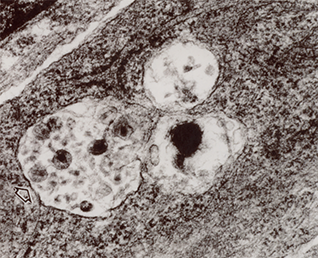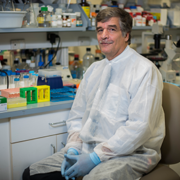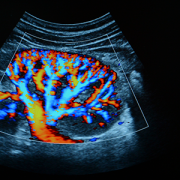‘Trojan horse’ macrophage TNF-alpha opens door for HIV-1 to enter kidney epithelial cells, causing nephropathy

Like a Trojan horse, the macrophage sits atop the epithelial cell with HIV hidden inside, opening a doorway into the kidney cell for high levels of HIV-1 to enter.
When nephrologist Patricio Ray, M.D., began investigating human immunodeficiency virus (HIV) as a renal fellow, children infected with the virus had a life expectancy of no more than seven years, and kids of African descent curiously were developing a type of HIV-related kidney disease.
HIV-associated nephropathy (HIVAN) is a progressive kidney disease seen in people who are both HIV-positive and of African ancestry. Kids who carry a modified protein that protects them against sleeping sickness are 80 times more likely to develop this type of kidney disease. Due to the kidney damage, they can have abnormal amounts of protein in their urine, focal segmental glomerulosclerosis, and microcystic tubular dilation, which can lead to enlarged kidneys and chronic kidney failure.
“No one understood how HIV could affect kidney cells that lack the receptors expressed in T cells and white cells,” recalls Dr. Ray, Robert Parrott Professor of Pediatrics at Children’s National Health System. Virologists said kidney epithelial cells that lacked CD4, a major receptor where HIV attaches, could not be infected with the virus. Nephrologists, meanwhile, were seeing that HIV infection was damaging these cells.
It’s taken two decades to unravel the medical mystery, aided by urine samples he coaxed kids to donate by offering them the latest music from New Kids on the Block in exchange for each urine bottle. Many of the kids died years ago, but their immortalized cells were essential in determining, through a process of elimination, which renal cell types were capable of being infected by HIV-1.
The paper represents the capstone of Dr. Ray’s career.
“This is how difficult it is to get an important contribution in science,” he says. “It’s 20 years of work involving the excellent contributions of many people, but that’s why research is called research. In the end, it’s all a learning process. But, it’s amazing how the puzzle pieces begin to fit. When the puzzle fits, it’s good.”
Dr. Ray, in collaboration with lead author Jinliang Li, Ph.D., and four additional Children’s National co-authors, published a paper November 3 in the Journal of the American Society of Nephrology that establishes a new role for transmembrane TNF-alpha, that of a facilitator that makes it easier for the HIV virus to enter certain cell types and replicate there. Like a Trojan horse, the macrophage sits atop the epithelial cell with HIV hidden inside, opening a doorway into the kidney cell for high levels of HIV-1 to enter.
As a starting point, the research team cultured podocytes from the urine of kids with HIVAN. Through a number of steps, they isolated the unique contributions of the HIV envelope, heparan sulfate proteoglycans as attachment receptors – the glue that binds HIV to podocytes – and the essential role played by TNF-a, a 212-amino acid long type 2 transmembrane protein, in regulating at least two processes, including viral entry and fusion. They used a fluorescent marker to tag HIV-1 viruses, so it lit up bright green. Thus primed with transmembrane TNF-a, the podocytes were susceptible to HIV-1 infection when exposed to high viral loads.
Additional research is needed, such as in vitro work to help understand how HIV traffics within the cell, Dr. Ray says. Those insights could winnow the list of existing therapies that could block key steps, such as attachment to the viral envelope, which could help all people of African descent carrying the genetic mutation, including underserved kids in sub-Saharan Africa.
Another open research question is that certain cells located in the placenta and cervix express TNF-a, and may be more likely to be infected by HIV. Blocking that process could help prevent pregnant HIV-positive mothers from transmitting illness to their offspring.










